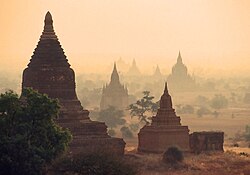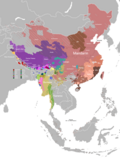Bamar
The Bamar (Burmese: ဗမာလူမျိုး bama loo-myo), Burmese or Burmans are the largest ethnic group in Myanmar.[2] The Bamar live around the Irrawaddy River. They speak the Burmese language, the official language of Myanmar.[2]
| Total population | |
|---|---|
| c. 32 million | |
| Regions with significant populations | |
| ~30,110,000 | |
| ~2,890,000[1] | |
| 107,112 | |
| 72,368 | |
| 96,420 | |
| 15,800 | |
| 22,000 | |
| 66,500 | |
| 9,800 | |
| 7,300 | |
| 5,400 | |
| 4,700 | |
| Languages | |
| Burmese | |
| Religion | |
| Burmese folk religion and Theravada Buddhism | |
| Related ethnic groups | |
| Sino-Tibetan peoples | |
Where they are from
The Burmese-speaking people first migrated from Yunnan, China to the Irrawaddy valley in the 7th century. Over the following centuries, the Burmese absorbed other groups like the Pyu.[3] DNA tests show that the Bamar are East Eurasian, related to Southeast Asian and Northeast Asian people. But they also have "Indian influences".[3]
What they speak
The Bamar speak Burmese, a Sino-Tibetan language. So basic words are related to Chinese language and Tibetan language. Many words related to Buddhism are borrowed from Pali. The Burmese alphabet itself is based on Indian scripts.
Bamar Media
Wet rice cultivation is closely associated with the Bamar.
Saya Chone's "Royal Audience," a traditional painting depicting the Mandalay Palace's royal audience hall
Myanmar's seven regions (in pale yellow) are home to the majority of the Bamar.
Men on an ox-drawn cart in Bagan, a historic royal capital in the Anya region, the cultural heartland of the Bamar.
The Myazedi inscription, dated to 1113, is the oldest surviving stone inscription of the Burmese language.
References
- ↑ CIA World Factbook – Thiland Archived 2010-12-29 at the Wayback Machine; 1.3% of the estimated 68.41 million people in July 2017.
- ↑ 2.0 2.1 "The World Factbook — Central Intelligence Agency". www.cia.gov. Archived from the original on 2010-11-04. Retrieved 2018-07-09.
- ↑ 3.0 3.1 Summerer, Monika; Horst, Jürgen; Erhart, Gertraud; Weißensteiner, Hansi; Schönherr, Sebastian; Pacher, Dominic; Forer, Lukas; Horst, David; Manhart, Angelika (2014). "Large-scale mitochondrial DNA analysis in Southeast Asia reveals evolutionary effects of cultural isolation in the multi-ethnic population of Myanmar". BMC Evolutionary Biology. 14 (1): 17. doi:10.1186/1471-2148-14-17. PMC 3913319. PMID 24467713.








